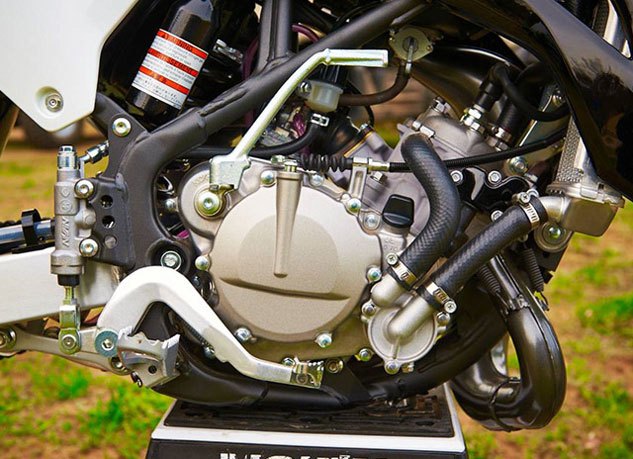2014 Kawasaki KX85 and KX100 Previews
For 2014, Kawasaki is introducing significantly updated versions of both the KX85 and the KX100 in an effort to stay one step ahead of its rivals in the never-ending battle for mini motocross supremacy.
The Kawasaki KX85 possesses a legacy that few motocross machines can match. The KX85 and its slightly larger sister, the KX100, are responsible for developing more young talent than any other manufacturer during the past three decades.
Both KX models benefit from numerous changes to their liquid-cooled, two-stroke, engines, resulting in a claimed 20% more peak power than the previous models, with an emphasis on mid-range torque and top-end power. Of course, the bore and stroke measurements between the two machines differ slightly, pistons in both travel a 45.8mm stroke, but the KX100 takes the 85cc’s 48.5mm bore and expands it to 52.5mm.
This additional oomph comes via a revised cylinder head combustion shape designed to increase power at all rpm, along with a new lightweight Nikasil-coated cylinder with a revised exhaust port shape for better flow. Both the KX85 and the KX100 get a new piston with a single-ring design (rather than two rings) to reduce friction for increased power, and the KX85’s piston now utilizes a longer piston pin for greater reliability.
VIEW: Read our review of the 2010 Kawasaki KLX110 and KLX110L
Kawasaki engineers also revised the KX’s Kawasaki Integrated Power Valve System (KIPS), which varies exhaust-port height for increased horsepower and torque at all rpm, by replacing the old three-piece valve design with independent valves and retuning the system for a broader powerband. The new valves are also claimed to increase reliability and decrease the need for cleaning and adjustment to the KIPS. A new breather in the KIPS cover is also claimed to improve top-end overrev performance, of which there can never be enough on a screaming two-stroke mini. The KX’s 28mm Keihin PWK carburetor has also been rejetted to deliver quicker throttle response and a smoother power delivery.
Increasing the power required other enhancements to improve reliability. A new cylinder head gasket and gasket retention dowel prevents detonation, while the new, larger, outer diameter crankshaft now measures 83mm (2mm larger than the previous model) for increased rigidity and durability. The big-end bearing on the connecting rod also features a more rigid cage. Both machines also get new radiators that increase cooling capacity by nearly 52% to keep them cool during long motos.
The KX 85/100’s high-tensile steel perimeter frame returns basically unchanged for 2014, but Kawasaki engineers have fitted it with new suspension components. Up front, a 36mm inverted cartridge fork incorporates new shim-type valving intended to provide more precise damping control. The fork also gets firmer damping rates to increase bottoming resistance. The fork also features 20-way adjustable compression damping.
Out back, Kawasaki’s proprietary Uni-Trak rear suspension features a new KYB reservoir shock with a black-anodized aluminum body that saves 150 grams of weight from the machine. The shock also gets a new clicker-type compression damping adjuster allows for more precise damping adjustments, which include 24-positions for compression damping, 21 positions for rebound damping, plus stepless spring preload adjustability.
VIEW: Read our review of the 2014 Kawasaki KX250F and KX450F
Kawasaki has also made changes to the mini KX platform to improve ergonomics and make both machines more adjustable and adaptable for riders of various shapes and sizes.
For starters, the KX85 gets a new 32.7-inch seat height that is 0.4 of an inch lower than the 2013 model to help growing riders touch the ground easier (the KX100’s 34.3 inches). Both machines also get a new fuel tank design that features a flatter top area for smoother seating, as the tank cap is moved 20mm lower to extend available room for the rider.
The KX’s handlebars are now 24mm wider and 22mm taller for increased comfort and improved leverage. The bars are mounted to new three-position handlebar risers that offer standard, +5mm higher and +10mm higher bar positioning along with new two-position handlebar clamps that offer standard and +10mm forward bar location for a total of six different handlebar positions.
Both bikes also get new petal-type brake rotors (220mm front/184mm rear) and a new front brake hose routing that helps protect the brake line better. The direct upward routing of the line is just like the big KXs, and it also simplifies brake bleeding and maintenance
The KX85 and KX100 feature new styling cues to match the big boys. Slimmer radiator shrouds and side panels look sleek and also improve rider ergonomics, and the seat features a seamless seat cover and gripper material that looks great and is also supposed to improve comfort and make weight shifts easier.
A new swingarm surface finish matches big KXs and is easier to clean, while the angular front fender, angular rear fender and number plate design are intended to match the styling of the big KXs.
The minis also receive new wraparound fork guards with embossed Kawasaki logo to protect inner fork tubes and also enhance styling. Their grey clutch and ignition covers are intended to resist the signs of boot rub to help keep the KX looking fresh, while factory lime green “flow line” graphics and black alumite coatings mirror the treatment on reigning AMA Supercross Champion Ryan Villopoto’s factory bike. Both machines ride on black alumite-coated aluminum rims and new Dunlop Geomax MX51 tires.
More by Scott Rousseau











































Comments
Join the conversation